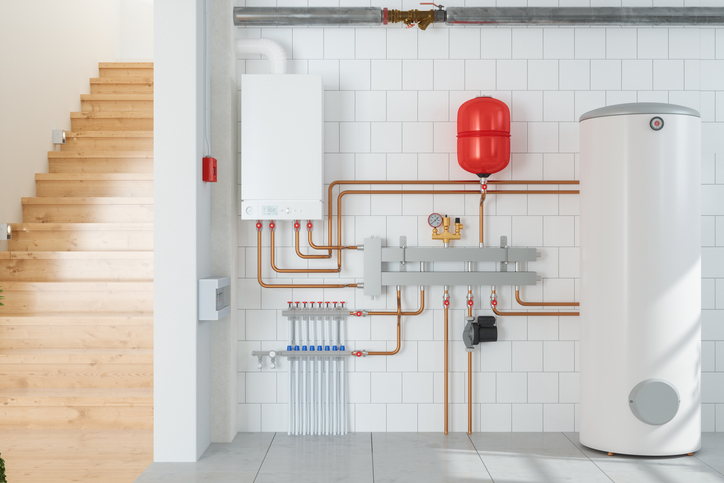Introduction
Water expands when it’s heated—this simple fact has serious implications for closed plumbing systems. Without a designated space for expanding water to go, pressure rises rapidly, placing stress on pipes, valves, and your hot water system. That’s where expansion tanks play a crucial role. While often overlooked, these small devices provide critical pressure relief and safeguard the overall plumbing infrastructure. The purpose of expansion tank design is to manage thermal expansion and prolong the life of your hot water equipment. When paired with routine system checks, they prevent costly breakdowns and reduce the risk of hidden leaks.
Expansion Tank Role in Thermal Expansion Control
1. What Is an Expansion Tank and Why Does It Matter
An expansion tank is a small, cylindrical device installed near your water heating system. Inside, a flexible bladder separates air from water to help regulate pressure. When hot water expands, the tank absorbs the surge to keep the system balanced. Without this buffer, pressure buildup can cause valve wear, leaks at pipe joints, or even ruptured tanks. Many municipalities now mandate them in homes with closed-loop systems or backflow prevention. The core expansion tank’s purpose is to control thermal expansion by absorbing pressure spikes, helping prevent damage to plumbing components rather than acting as a water storage unit.
2. How Thermal Expansion Affects Plumbing Systems
Thermal expansion isn’t a problem in an open system, where water can flow backward into the supply line. But in closed systems—where water can’t move in reverse—the increase in volume has no outlet. Each time water heats, it expands slightly and builds up force. Over time, this repeated pressure stresses plumbing components. Faucets may drip, relief valves may constantly release water, or pipe joints might loosen. This silent wear leads to water damage that often goes undetected. The purpose of water heater expansion tank usage is to catch this buildup early by giving water a space to expand into safely.
3. Protecting the Water Heating System and Preventing Relief Valve Issues
Water heating equipment is built to handle standard pressure levels. However, without an expansion tank, the extra strain can lead to overheating, cracked tanks, or constant triggering of the temperature and pressure relief valve (T&P valve). This valve is a safety feature, but if it activates frequently, it indicates a problem with pressure balance. In extreme cases, a stuck valve could lead to flooding or dangerous blowouts. Installing an expansion tank alleviates this repeated stress by absorbing the pressure before it reaches the heater or safety valve. The hot water expansion tank’s purpose is to manage rising pressure levels, protecting your heater and safety valves from long-term wear and unexpected failure.
4. Signs You May Need an Expansion Tank Now
Even if your plumbing system seems fine, hidden symptoms of thermal expansion might be present. Some telltale signs include banging pipes, dripping relief valves, or fluctuating water pressure. Homeowners may also notice inconsistent hot water delivery or strange noises when the heating system starts. If your water heater was recently replaced or upgraded to a higher capacity, pressure issues can become more noticeable. These indicators suggest that expanding water has no buffer, which compromises your entire system. The expansion tank installation becomes urgent when these symptoms point to a pressure imbalance inside your closed-loop system.
5. Proper Sizing and Placement for Long-Term Performance
Installing an expansion tank isn’t just about adding a component—it’s about selecting the right size and location. Tanks come in various capacities, and the proper one depends on your hot water unit size, system pressure, and water supply setup. Too small, and the tank fills up too quickly. Too large, and it becomes inefficient. Placement typically involves connecting it above or near the hot water unit on the cold water supply line. This positioning allows the tank to capture expanded water before it travels downstream. The pressure control tank placement is not random—it must be optimized for the system’s pressure and flow characteristics.
Thermal expansion might be invisible, but the damage it causes isn’t. From cracked pipes to failed hot water equipment, unchecked pressure buildup slowly erodes the integrity of your plumbing. Installing the right expansion tank acts as a pressure buffer that protects valves, reduces repair frequency, and maintains system stability over time. Understanding the purpose of expansion tank design and placement helps homeowners take proactive steps toward safer, longer-lasting plumbing. Whether you’re upgrading a hot water system or troubleshooting recurring pressure issues, this small device offers a powerful solution.
Conclusion
Protect your plumbing with expert insight into the purpose of expansion tank use. Call Drain Flo Plumbing at (813) 391-1500 for smart installations that help maintain long-term pressure control. Contact us for any further inquiries!
📌 Your Local Comfort Experts — Now Serving You as Drain Flo Plumbing with the Same Fast, Reliable Plumbing Solutions You Trust.


